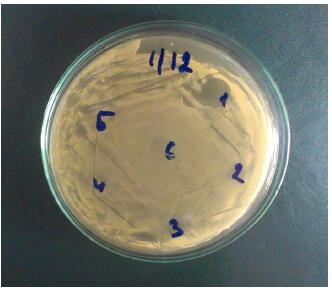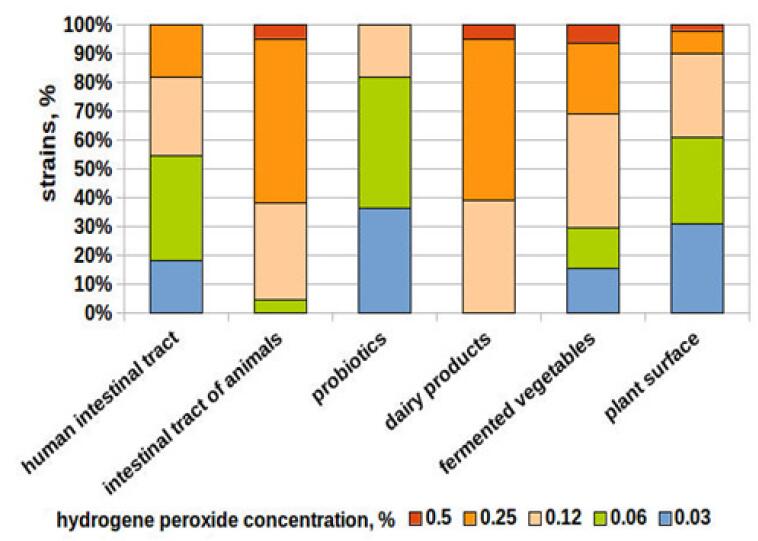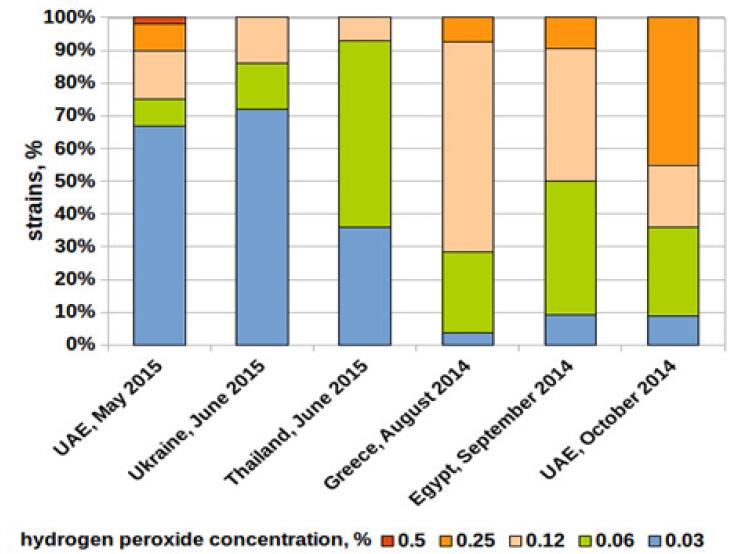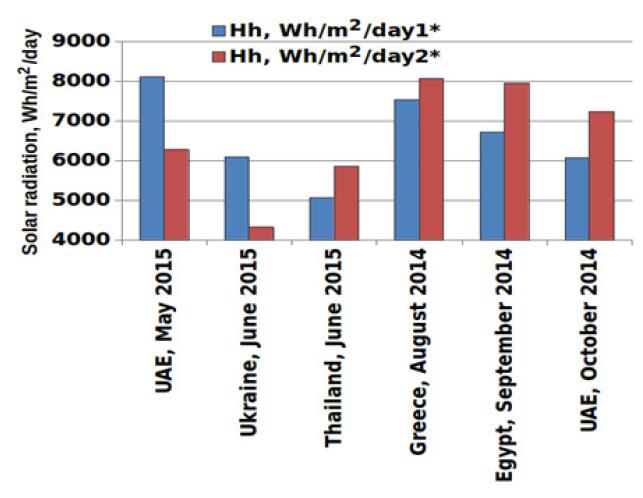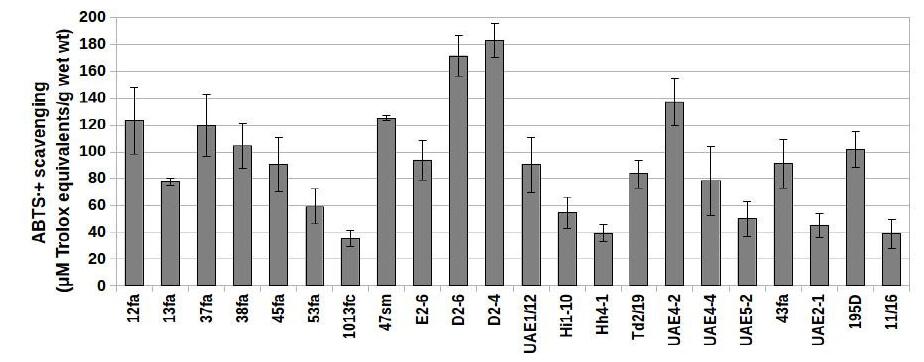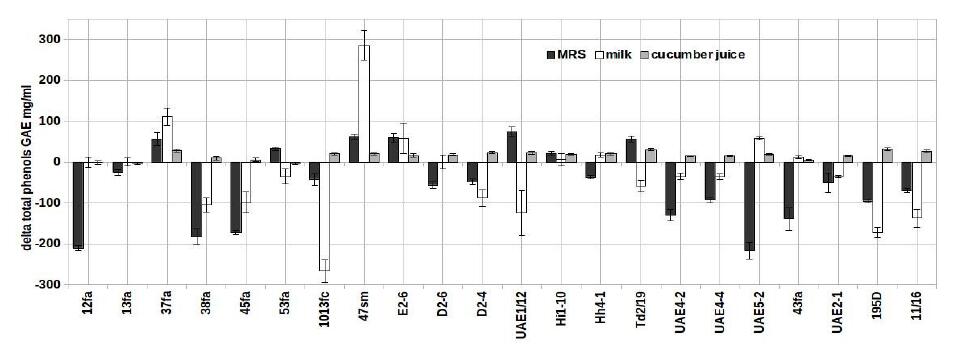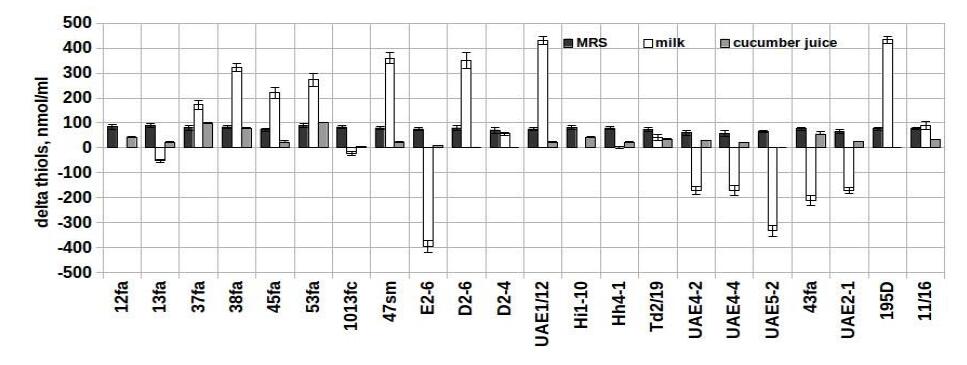1. Introduction
Oxidative stress-associated damages underlay the pathology of wide range of human diseases and aging processes. Different metabolic disorders, diabetes, obesity, kidney and heart diseases, atherosclerosis, and neurodegenerative diseases all have a strong component of oxidative stress [1]. Antioxidant therapy can not be considered as panacea against aging in general. However the balanced consumption of nutrients with antioxidant properties is a necessity for health maintenance and healthy aging [2]. There are many unanswered questions concerning the consumption efficacy of antioxidant preparations in vivo and its ability to provide the claimed effects under gastrointestinal tract conditions [3]. Contemporary scientific evidence indicates that total antioxidant capacity measured by currently popular chemical assays may not reflect the actual activity in vivo since none of them take biological processes such as bioavailability, uptake, and metabolism into account [4]. From a physiological perspective, food after consumption undergoes a gastrointestinal digesting process that may affect the native antioxidant potential of the bioactive compounds or medical preparations before reaching the proximal intestine [5]. In this regard, special attention is drawn to the antioxidant properties of LAB that could act not only as probiotics but also might provide antioxidant effect at the local and general levels, in particular to produce antioxidant substances in GI tract or to improve antioxidant status indirectly. The dramatic increase of the publications on that topic during last years obviouslyconfirms the relevance of the studies which are focused on finding and characterisation of the new LAB strains, its antioxidant activity investigation and industrial implementation [6,7]. In this regard the new strains isolation and screening for potential probiotic properties are of great importance. Meanwhile plant surface ecotope is of particular interest due to solar irradiation, as it is known to be a factor of oxidative stress which can act as the selective factor.
Hydrogen peroxide is a widely used agent in oxidative stress modeling. Although the oxidative processes occurring under solar irradiation and hydrogen peroxide effect are not absolutely identical, its impact allows to evaluate non-enzymatic (non-specific) antioxidant defence mechanisms of cells. Since the final goal of these studies is to obtain strains that could produce extracellular antioxidant metabolites to be included into probiotic compositions, this study model can be considered quite representative. The majority of hydrogen peroxide sensitivity methods are mainly laborious and inappropriate for screening of large number of strains during investigation. The study has aimed to develop a simple modification of method for screening of LAB for their potential antioxidative properties, and to study their total antioxidative activity, polyphenolic, and thiolic compounds production on different media.
2. Materials and Methods
2.1. Strains
The strains from bacteria collection and new strains isolated from various environmental and food sample were characterised (Table 1). Also the strains from several probiotic preparations were taken for comparison with further results. Collection strains were previously isolated, identified, studied by our colleges, and have been kindly provided for the current studies (Ukrainian collection of microorganisms, UCM) [8,9]. Among them there were: LAB of Lactobacillus and Leuconostoc genus, isolated from wide spectra niches-fermented apples, cabbage, aubergines, fermented milk, cottage cheese, sour cream, and distant intestine content.
Table 1. Strains of lactic acid bacteria used in this study.
| Strains origin | Number of strains |
| Collection strains | 168 |
| Human intestinal tract (Lactobacillus) | 19 |
| Intestinal tract of animals (Lactobacillus) | 38 |
| Dairy products (Lactobacillus) | 19 |
| Fermented vegetables (Lactobacillus, Leuconostoc) | 93 |
| Newly isolated strains | 210 |
| Greece, August 2014 (Lactobacillus) | 27 |
| Egypt, September 2014 (Lactobacillus) | 28 |
| UAE, October 2014 (Lactobacillus) | 25 |
| UAE, May 2015 (Lactobacillus) | 47 |
| Ukraine, June 2015 (Lactobacillus) | 34 |
| Thailand, June 2015 (Lactobacillus) | 27 |
| Probiotics (Lactobacillus) | 22 |
| Total | 378 |
The newly obtained strains were isolated from 50 samples of plant leaves belonging to Magnoliophyta phylum preferably from locations with hot climates (United Arab Emirates (UAE), Egypt, Thailand, Greece) or with increased radiation level (Ukraine, Chornobyl). All leaves were sampled between May-August 2014-2015. Only the leaves that were under the direct solar irradiation (factor of oxidative stress) were collected. The monthly index Hh1(irradiation on horizontal plane, Wh/m2/day) was calculated using database PVGIS-CMSAF. The Hh2 (average irradiation per 3 month before the samples collection) had also been taken into consideration.
The samples were put into the sterile tubes with MRS medium [10], following sterility, and transferred to the laboratory within 2-3 days. During that period, possible shift in temperature was in the range of 18-24 °C. The samples in MRS broth were incubated at 37 °C during 18-24 hours. After that, purification of the samples was performed on the MRS agar, to get pure strains. Only catalase-negative, Gram-stained positive, rode shaped isolates were selected. The isolates were identified by 16S rRNA based PCR-method as described previously [11].
To perform the thiol and phenolic content study the strains were grown in MRS broth, commercial pasteurized milk [0.5% (w/w) fat], and cucumber juice for 24 h under microaerobic condition at 37 °C (the inoculum volume was 5%). The cucumber juice was freshly prepared and pasteurized at 65 °C for 20 min.
The cells suspensions were centrifuged (6000 g, 15 min) and the supernatants were used for the thiol and phenolic content assays.
2.2. Screening of potential antioxidant properties
To evaluate the potential antioxidant properties of the large number of strains the simple spot test had been developed. The bacteria liquid culture was spread on the MRS-plate and afterwards the freshly prepared hydrogen peroxide (puriss p.a., Sigma-Aldrich) solutions were dropped on the agar surface. The concentrations of 0.5, 0.25, 0.12, 0.06, 0.03% hydrogen peroxide were used. The plates were incubated for 18-24 hours at 37 °C. For further study only the samples which survived the highest concentration of hydrogen peroxide were used.
2.3. Total antioxidative activity assay
The selected strains were grown in MRS broth for 24 h under microaerobic conditions at 37 °C. The cells were harvested by centrifugation at 4000 rpm for 10 min. Cell pallets were then washed twice with sterile saline solution (0.90% NaCl, w/v). Total cell numbers were adjusted to 108 cfu/ml. The total antioxidative activity (TAA) of strains was evaluated by scavenge ABTS+ radical cation and compared to Trolox standard (Sigma-Aldrich) [12]. The ABTS+ radical cation was pregenerated by dissolving ABTS in solution of 2 mM H2O2 in 30 mM acetate buffer (pH 3.6) to final ABTS concentration of 10 mM, and incubating for 1 hour in the darkness at room temperature until characteristic color of ABTS+ had appeared. The incubating samples were prepared by mixing 150 µl of 0.4 M acetate buffer solution (pH 5.8), 15 µl of 10 mM ABTS+ solution and 10 µl of native bacteria suspensions in PBS. The rate at which absorbance of ABTS+ cation radical at 414 nm dropped in the presence of bacteria cells was monitored using Labsystem Multiskan MS. Solutions of Trolox within a concentration range from 9 to 90 µM were used as standards for calibration curve [13].
2.4. Total thiol content assay
Total thiol content was measured spectrophotometrically according to a modified Ellman’s method [14]. The 50 µl of sample was dropped into 1350 µl of KBK buffer (pH 8.0), and DTNB reagent [5, 5’ dithiobis-(2-nitrobenzoic acid), 75 µl of 1 mM solution, (Sigma-Aldrich)] was added. Absorbance was measured after 30 min at room temperature at 412 nm. The thiol concentrations were expressed as micromoles of SH-groups per gram of bacteria wet weight [15].
2.5. Total phenolic content measured by Folin-Ciocalteau reagent
An aliquot (1 ml) of supernatant was introduced into a test-tube with 5 ml 0.5 M Na2CO3 solution and was mixed briefly with 1 ml Folin-Ciocalteu reagent. The solution was stirred and allowed to stand for 30 min. The absorbance of the supernatant was measured at 725 nm and data were expressed as micrograms gallic acid equivalent (GAE)/g (Sigma-Aldrich) [16,17].
2.6. Statistical analysis
The mean, standard deviation and correlation has been calculated using Exel and StatSoft software. All analyses were carried out in triplicate.
3. Results and Discussion
In total 378 strains of LAB were tested in this study. Among them there were 168 collection strains and 210 newly isolated from plant surface and probiotic preparations. It is noteworthy that LAB were not always isolated from phylloplane. From 50 plant samples, only 29 gave cultivable LAB. Melanin producing Bacillus strains were observed in many plant samples suggesting the high level of oxidative stress in this ecotope.
All new isolates were selected for typical colonies formation on the MRS agar without catalase activity, gram positive staining, and rod shape cells. All strains were tested for surviving under the different concentrations of hydrogen peroxide as a factor of oxidative stress (Figure 1). Hydrogen peroxide sensitivity assay was also used previously [18,19] to estimate LAB antioxidant properties or selection of mutants tolerant to oxidative stress [20]. As the methods used in those studies were not appropriate for the high put-through tests with numerous strains, we have developed a simple and not labor intensive spot-test method.
The strains that are most resistant to hydrogen peroxide were isolated from plant surfaces, fermented vegetables, intestinal tract of animals, and homemade dairy products (Figure 2).
It should be noted that the highest H2O2 concentration, which the strains from probiotic preparation could survive, was only 0.12%. The least heterogeneity in terms of hydrogen peroxide resistance was found for strains isolated from dairy products, which might be explained by relatively stable ecotope conditions.
It was expected to observe more resistant strains from plant surface because of active solar radiation and a predictably higher level of antioxidative defence systems. The hydrogen peroxide resistance of the studied strains was found to depend not as much on the geographic area of sampling as on solar irradiation (Figure 3,Figure 4). More resistant strains were isolated from the areas with higher solar activity. There were no isolates resistant to 0.25 % hydrogen peroxide among strains collected from the areas with lower solar irradiation at the moment of sampling: Ukraine and Thailand. The radiation level of sampling area in Thailand was low due to the monsoon period that had preceded the sampling time. It should be noted that the samples from Ukraine were collected from Chornobyl Exclusion Zone as an area which underwent strong radiation associated with oxidative stress after the Chornobyl accident in 1986. However the radiation level of sampling points was 0.15-0.38 µSv/h considered as upper range of acceptable. Also, in general, the sharp reduction of the less peroxide resistant strains isolated during the second part of season could be observed, which correlated with Hh2 index (Pearson’s r-0.88).
Our study was focused on LAB strains possessing antioxidant properties. The strains with high hydrogen peroxide resistance were selected for further tests. We also analyzed as the reference strains several LAB isolates with weak resistance to hydrogen peroxide, as well as two commercially established probiotic strains with studied probiotic properties (Table 2).
Table 2. Lactic acid bacteria strains selected by hydrogen peroxide resistance screening.
| No | Strain | Isolation source | Hydrogen peroxide concentration, % |
| 1 | 12fa (Leuconostoc sp.) | fermented apples | 0.5 |
| 2 | 13fa (Leuconostoc sp.) | fermented apples |
| 3 | 37fa Leuconostoc sp.) | fermented apples |
| 4 | 38fa (Leuconostoc sp.) | fermented apples |
| 5 | 45fa (Leuconostoc mesenteroides) | fermented apples |
| 6 | 53fa (Leuconostoc sp.) | fermented apples |
| 7 | 1013fc (Lactobacillus plantarum) | fermented cabbage |
| 8 | 47sm (Lactobacillus plantarum) | sour cream |
| 9 | E2-6 (Lactobacillus sp.) | plant surface (Egypt) |
| 10 | D2-6 (Lactobacillus sp.) | plant surface (UAE) |
| 11 | D2-4 (Lactobacillus sp.) | plant surface (UAE) |
| 12 | UAE1/12 (Lactobacillus plantarum) | plant surface (UAE) |
| 13 | Hh1-4 (Lactobacillus sp.) | chicken GIT |
| 14 | Hi1-10 (Lactobacillus sp.) | chicken GIT |
| 15 | 43fa (Leuconostoc sp.) | fermented apples | 0.03 |
| 16 | Td2/19 (Lactobacillus sp.) | plant surface (Thailand) |
| 17 | UAE2/1 (Lactobacillus sp.) | plant surface (UAE) |
| 18 | UAE4/2 (Lactobacillus sp.) | plant surface (UAE) |
| 19 | UAE4/4 (Lactobacillus sp.) | plant surface (UAE) |
| 20 | UAE5/2 (Lactobacillus sp.) | plant surface (UAE) |
| 21 | 195D (Lactobacillus plantarum) | long-livers GIT* | 0.06 |
| 22 | 11/16 (Lactobacillus plantarum) | plant surface | 0.12 |
| *GIT: gastrointestinal tract |
All these strains more or less demonstrated antioxidant properties (Figure 5). In general, the strains with the highest antioxidant activity belonged to the strains highly-resistant to hydrogen peroxide.
In terms of commercial potential of the strains the most promising feature would be the ability of microorganisms to produce exogenous metabolites with antioxidant properties or to enrich the culture medium with such substances indirectly. Such substances could be the compounds containing phenol or thiol functional groups [21,22].
The accumulation in medium of these substances was studied during cultivation of tested strains on MRS broth, milk and cucumber juice, as model of raw plant material (Figure 6,Figure 7).
Only a third of the studied strains produced phenolic compounds in the MRS medium. The same number of strains had the ability to increase the amount of phenolic compounds in milk.
The majority of studied strains ( >90%) produced phenolic substances in the cucumber juice. Only three strains were able to produce phenolic substances in all tested media. These strains were also characterized by the high antioxidant activity. It was found that plant-derived strains had produced phenolic compounds only when grown on plant-based medium cucumber juice, but were not capable to produce these compounds in milk or MRS medium. It is known that phenolic compounds increase during LAB fermentation of plant-based foods, influencing food aroma as well as increasing antioxidant activity [21,23].
These benefits are considered as being provided due to the depolymerization of high molecular weight phenolic compounds, bioconversion of the conjugated forms of phenolic compounds into their free forms improves their health-linked functionality which could be realized by LAB fermentative activity [24,25,26]. Only plants and microorganisms are able for the synthesis of phenolic compounds precursors [27]. It is worth mentioning that in our study in some cases polyphenols were increased in the MRS medium and in milk. There is a lack of such studies and it has been suggested to fortify milk beverages with phenolic compounds extracted from plants [28]. This reaffirms the importance of the search for LAB strains suitable for the commercialization of such biotechnology.
Thus, the source of strain isolation affects the production of phenolic compounds which should be considered in the further use of bacterial cultures to improve the biological value of functional food.
Another important group of substances with antioxidant properties are thiols which are distributed widely in biological systems and represent an important class of compounds engaged in stress protection [29]. Usually it could be proteins and peptides that are even of special interest for engineering of antioxidant LAB strains [30]. There are studies on thiol associated cell defence systems against oxidative stress, but the data on bacterial thiol metabolites increasing antioxidative properties of probiotic products are limited [31]. In our study all investigated strains increased thiol content when cultured in the medium MRS (Figure 7). Most strains produced the thiols in the cucumber juice. There are also several publications about the thiol increase in plant based foods however there is a lack of such data about milk based products [22]. More than half of the strains resistant to peroxide had produced thiols in milk, in contrast almost all of more peroxide sensitive strains substantially reduced thiol concentration in the medium. Out of the 14 strains resistant to higher concentrations of peroxide, 6 strains were able to synthesize thiols in all three media whereas among less resistant strains only one strain had increased thiols amount in all media. The thiols production by LAB is understudied and needs further investigation.
Thus production of thiolic and phenolic compounds by LAB depended both on the strain and its origin.
4. Conclusion
The hydrogen peroxide sensitivity spot-test was suggested for LAB antioxidant properties screening. The most resistant strains to hydrogen peroxide were isolated from plant surfaces, fermented vegetables, intestinal tract of animals, and homemade dairy products. The hydrogen peroxide resistance of the strains isolated from phylloplane was found to depend not as much on the geographic area of sampling as on solar irradiation. Strains that are more resistant were isolated from the areas with higher solar activity. It was found that strains isolated from plant substrates produced phenolic compounds only when grown on plant based medium (cucumber juice) but were not capable to produce these compounds in milk or MRS medium. More than half of strains resistant to higher concentrations of peroxide were able to synthesize thiols in all three tested media whereas among less resistant strains, less than one-fifth of them increased thiols amount in all media. Future research is needed to identify the antioxidant compounds produced by the selected LAB strains using GC and HPLC methods, and to clarify whether the strains produce novel antioxidant compounds or convert these from the growth media. So the current data may demonstrate the strain selection by environmental factors and consolidate the approaches to purposeful strains screening.
Acknowledgments
Our special thanks go to Marina Fomina (D.K. Zabolotny Institute of microbiology and virology of National Academy of Ukraine, Department of Physiology of industrial microorganisms) for inspirational discussions and help in editing.
Conflict of Interest
All authors declare no conflicts of interest in this study.









 DownLoad:
DownLoad: 